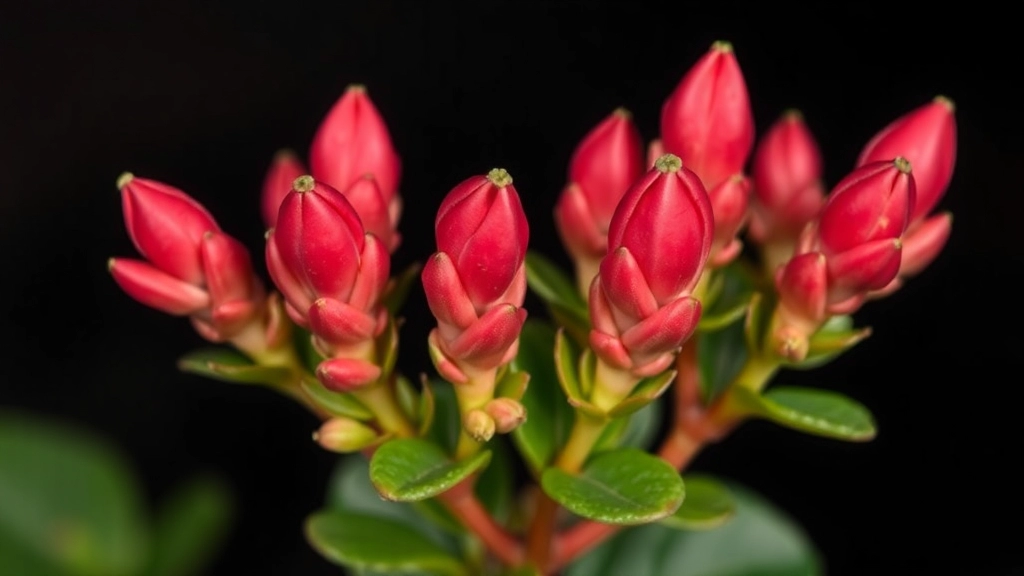Enhancing the Beauty of Kalanchoe Flower Buds
Are you looking to enhance the beauty of your Kalanchoe flower buds? You’re in the right place. As a Kalanchoe enthusiast, I’ve discovered some effective methods to stimulate flower bud formation and maintain their vibrant blooms. From ideal lighting conditions to essential watering tips, we’ll cover everything you need to know to keep your Kalanchoe thriving.
Key Tips for Encouraging Kalanchoe Flower Buds
To encourage Kalanchoe flower buds, start by ensuring they receive the right amount of light. These plants thrive in bright, indirect sunlight. Additionally, maintaining the correct temperature and providing well-draining soil are crucial for healthy blooming. Don’t forget to fertilise your Kalanchoe regularly to support strong flower buds. With these simple tips, you’ll enjoy a flourishing Kalanchoe with beautiful, long-lasting flowers.
Are you struggling to get your Kalanchoe to bloom? You’re not alone. Many plant enthusiasts face the challenge of encouraging flower bud formation in these beautiful succulents.
To help your Kalanchoe thrive and produce those stunning blooms, consider the following tips:
## 1. Light Exposure
– Kalanchoe needs plenty of bright, indirect sunlight.
– Aim for at least 6 hours of light daily.
– Too much direct sunlight can scorch the leaves, while too little light may hinder bud formation.
## 2. Proper Pruning
– Prune back any dead or wilted leaves.
– This helps the plant redirect energy towards new growth and blooming.
## 3. Temperature Control
– Keep your Kalanchoe in a warm environment.
– Ideal temperatures range from 15°C to 25°C.
– Avoid exposing it to cold drafts or sudden temperature changes.
## 4. Watering Routine
– Water your Kalanchoe only when the top inch of soil feels dry.
– Overwatering can lead to root rot, which can prevent blooming.
## 5. Fertilisation
– Use a balanced fertiliser every few weeks during the growing season.
– This provides essential nutrients that promote healthy flower bud development.
## 6. Stress Induction
– Sometimes, a little stress can encourage blooming.
– Reduce watering for a short period to stimulate flower bud formation.
If you want to dive deeper into specific care tips, check out our [complete care guide for Kalanchoe Blossfeldiana](https://planthq.org/complete-care-guide-for-kalanchoe-blossfeldiana-succulent/) and learn how to [grow Kalanchoe Blossfeldiana from seeds](https://planthq.org/how-to-grow-kalanchoe-blossfeldiana-from-seeds/).
Ideal Lighting Conditions for Kalanchoe Flowering
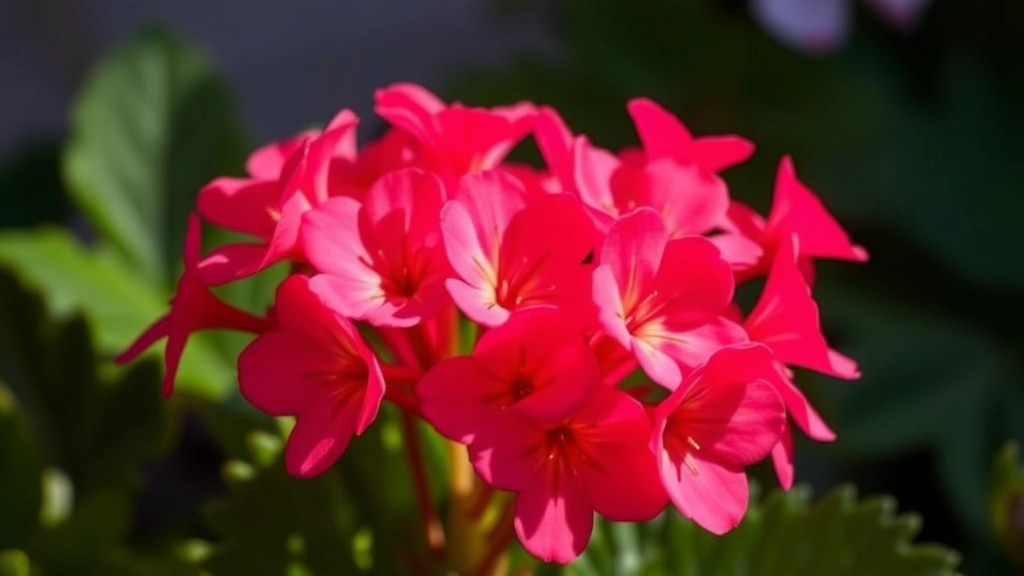
So, you’ve got your Kalanchoe and you’re eager to see those stunning flowers bloom.
But have you thought about lighting?
Lighting is crucial for Kalanchoe flowering.
Here’s the lowdown:
- Bright, Indirect Light: Your Kalanchoe thrives in bright, indirect sunlight. Think of a spot near a window where it can soak up the rays without getting scorched. Direct sunlight can lead to burnt leaves.
- Duration Matters: Aim for around 12-14 hours of light per day. This helps trigger that flowering magic. If natural light is lacking, a grow light can work wonders.
- Rotate Regularly: Every couple of weeks, give your plant a little twist. This ensures even growth and prevents it from leaning towards the light.
- Watch for Signs: If your Kalanchoe starts stretching or its leaves turn yellow, it’s a sign it’s not getting enough light. On the flip side, too much direct sun can cause leaf scorch.
Pro Tip: If you’re growing your Kalanchoe indoors, consider placing it on a windowsill that faces south or east.
Temperature Requirements for Healthy Blooming
Are you struggling to get your Kalanchoe to bloom? One crucial factor that often gets overlooked is temperature.
Kalanchoe thrives best in specific temperature ranges, which can significantly influence flower bud formation.
Optimal Temperature Range
- Daytime Temperatures: Ideally, keep your Kalanchoe in temperatures between 20°C to 24°C.
- Nighttime Temperatures: At night, a drop to 15°C to 18°C is beneficial.
Maintaining these temperatures helps promote healthy growth and flowering.
Temperature Fluctuations
- Avoid Extreme Heat: Temperatures above 30°C can stress the plant, leading to poor bud formation.
- Cold Sensitivity: Kalanchoe is sensitive to frost. Ensure it’s kept away from cold drafts or temperatures below 10°C.
Tips for Managing Temperature
- Indoor Placement: Place your Kalanchoe near a window but not in direct, harsh sunlight.
- Heating or Cooling: Use fans or heaters to maintain a consistent temperature, especially during seasonal changes.
By keeping your Kalanchoe within these temperature parameters, you can encourage vibrant blooms and robust flower buds. For more detailed advice, check out our Essential Fall Kalanchoe Care Tips for Healthy Blooms and our Causes and Solutions for Kalanchoe Leaves Curling.
Watering Tips During Flower Bud Development
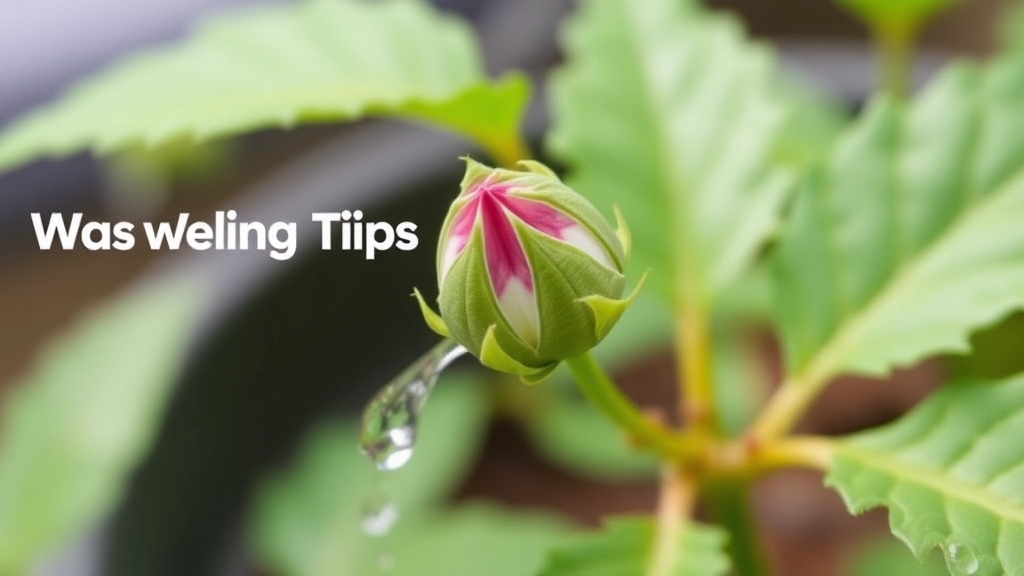
When nurturing Kalanchoe, one common concern is ensuring the right watering strategy during flower bud development. Overwatering or underwatering can significantly impact bud formation and overall plant health.
Understanding Watering Needs
- Soil Moisture: Kalanchoe prefers its soil to dry out between watering. Check the top inch of soil; if it feels dry, it’s time to water.
- Frequency: Typically, watering every 2-3 weeks is sufficient. However, this can vary based on environmental conditions.
- Signs of Overwatering: Yellowing leaves and a mushy stem are clear indicators. If you notice these, reduce your watering frequency.
- Signs of Underwatering: Droopy leaves and a shrivelled appearance signal that your Kalanchoe needs more water.
Watering Technique
- Water Thoroughly: When you do water, ensure it’s a deep soak. Water until it drains from the bottom of the pot, promoting healthy root growth.
- Avoid Water on Leaves: Water the soil directly to prevent fungal issues. Wet leaves can lead to rot, especially in humid conditions.
Adjusting for Seasons
- Summer: Increase watering frequency as the plant actively grows and develops buds.
- Winter: Reduce watering, as Kalanchoe enters a dormant phase.
When it comes to encouraging Kalanchoe to produce vibrant blooms, the right soil and drainage are essential components.
### Why Soil Matters
The foundation of any healthy plant starts with its soil. For Kalanchoe, a well-draining soil mix is crucial. Here are some key points to consider:
– **Soil Type:** A cactus or succulent potting mix is ideal. These mixes typically include sand or perlite, which helps with drainage.
– **pH Level:** Kalanchoe thrives in slightly acidic to neutral soil (pH 6.0 to 7.0). This range supports nutrient absorption, which is vital for flower bud formation.
– **Organic Matter:** While Kalanchoe prefers well-draining soil, a small amount of organic matter, like compost, can provide essential nutrients without compromising drainage.
### Importance of Drainage
Proper drainage is just as important as the soil type. Without it, you risk waterlogging, which can lead to root rot and hinder blooming. Here’s how to ensure good drainage:
– **Pot Selection:** Choose pots with drainage holes. This allows excess water to escape, preventing soggy roots.
– **Layering:** Consider adding a layer of gravel or small stones at the bottom of the pot. This creates a barrier that facilitates drainage.
– **Watering Technique:** Water your Kalanchoe thoroughly but let the soil dry out between waterings. This balance prevents overwatering while keeping the plant hydrated.
For more detailed care tips, you might find our [ultimate guide to growing and caring for succulent plant Kalanchoe](https://planthq.org/ultimate-guide-to-growing-and-caring-for-succulent-plant-kalanchoe/) useful. Additionally, understanding the [ideal temperature for Kalanchoe Blossfeldiana growth](https://planthq.org/ideal-temperature-for-kalanchoe-blossfeldiana-growth/) can further enhance your plant’s blooming potential.
Fertilizing Kalanchoe for Strong Flower Buds
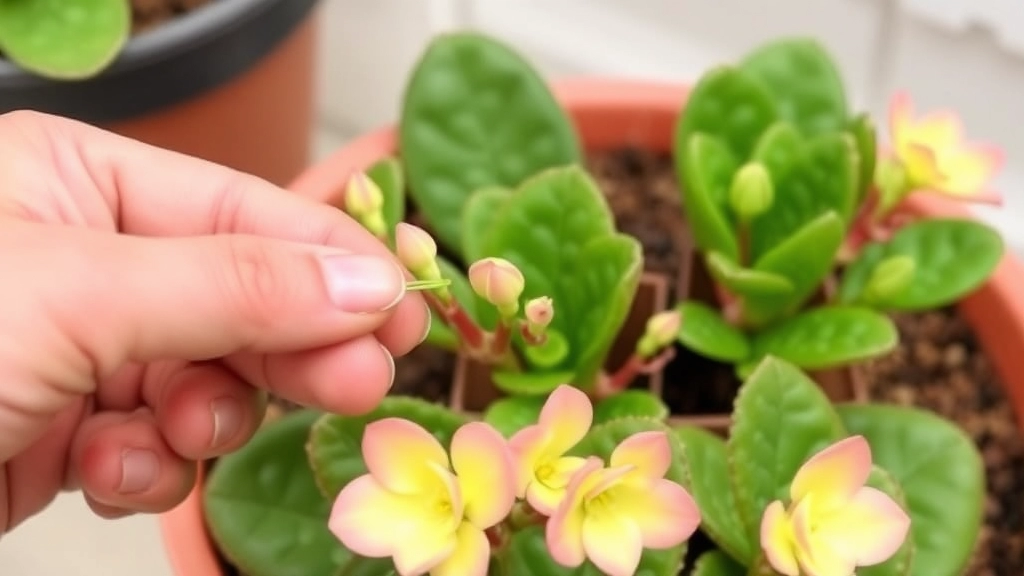
So, you’ve set the stage for your Kalanchoe to thrive, and now it’s time to talk about fertilizing. This step is crucial for encouraging those beautiful flower buds to form.
Why Fertilizing Matters
Fertilizing your Kalanchoe can make a world of difference. Just like us, plants need a balanced diet to flourish. The right nutrients can boost growth and enhance blooming.
What to Use
- Balanced Fertilizer: Look for a balanced formula, like a 10-10-10 NPK. This means equal parts nitrogen, phosphorus, and potassium.
- Liquid Fertilizer: A liquid feed is often easier to apply and absorbs quickly.
- Slow-Release Granules: These can be mixed into the soil for a steady supply of nutrients over time.
When to Fertilize
- Growing Season: Focus on fertilizing during the growing season, typically spring and summer. This is when your Kalanchoe is actively developing those buds.
- Every 4-6 Weeks: A good rule of thumb is to fertilize every 4 to 6 weeks. Just be careful not to overdo it!
How to Apply
- Dilute: Always dilute the fertilizer to half strength to avoid burning the roots.
- Watering: Apply after watering to help the nutrients soak into the soil without stressing the plant.
- Observe: Keep an eye on your plant. If the leaves start turning yellow, you might be over-fertilizing.
Signs Your Kalanchoe Needs More
- Stunted Growth: If your Kalanchoe isn’t growing as expected, it might be time for a nutrient boost.
- Poor Flowering: If the buds aren’t forming, a little extra fertilizer can help.
How Long Does It Take for Kalanchoe Buds to Bloom?
One common question among Kalanchoe enthusiasts is, “How long will it take for my Kalanchoe buds to bloom?” Understanding the blooming timeline can enhance your care routine and set realistic expectations.
Typically, Kalanchoe buds take 2 to 3 weeks to bloom after they first appear. However, several factors can influence this timeline:
- Light Conditions: Adequate light is crucial. If your Kalanchoe isn’t receiving enough bright, indirect sunlight, it may delay blooming.
- Temperature: Kalanchoe thrives in warmer temperatures, ideally between 20°C to 25°C. Cooler conditions can slow down bud development.
- Watering Practices: Overwatering can lead to root rot, while underwatering may stress the plant. Aim for a balanced watering schedule.
- Soil Quality: Well-draining soil promotes healthy roots, which is essential for timely blooming.
- Fertilization: A balanced fertiliser can provide the nutrients necessary for bud formation and blooming.
To summarise, patience is key. While you might be eager to see those vibrant flowers, giving your Kalanchoe the right conditions will ensure a successful bloom. For more detailed care instructions, check out our [expert tips for healthy growth](https://planthq.org/kalanchoe-beharensis-care-expert-tips-for-healthy-growth/) and [ideal temperature for Kalanchoe Blossfeldiana growth](https://planthq.org/ideal-temperature-for-kalanchoe-blossfeldiana-growth/).
VIII. Pruning Techniques to Maintain Flowering Health
So, you’ve been nurturing your Kalanchoe, and now you’re eager to see those vibrant blooms? Pruning is a key part of keeping your plant healthy and encouraging flower buds.
Why Prune?
Pruning isn’t just about aesthetics; it’s about promoting growth and flowering. Regularly trimming your Kalanchoe can help:
- Remove dead or wilted leaves
- Encourage bushier growth
- Stimulate new flower bud formation
When to Prune
Timing is everything! The best time to prune your Kalanchoe is right after it finishes flowering. This allows the plant to focus its energy on new growth.
How to Prune
Here’s a simple step-by-step guide:
- Gather Your Tools: You’ll need sharp, clean scissors or pruning shears.
- Identify What to Cut: Look for:
- Dead or yellowing leaves
- Spent flower stalks
- Overly long stems
- Make Clean Cuts: Cut just above a leaf node to encourage new growth.
- Don’t Overdo It: Aim to remove about one-third of the plant at a time.
After Pruning Care
Once you’ve pruned, give your Kalanchoe a little TLC:
- Water: Ensure it’s well-hydrated but not soggy.
- Light: Keep it in bright, indirect light to encourage new growth.
Common Issues Affecting Flower Buds and How to Fix Them
As we delve deeper into the care of Kalanchoe, it’s essential to address the common issues that can hinder flower bud formation. Understanding these challenges can help you maintain a thriving plant and ensure a stunning display of blooms.
1. Insufficient Light
Problem: Kalanchoe requires bright, indirect light for optimal flowering. If your plant is not receiving enough light, it may fail to produce buds.
Solution:
- Move your Kalanchoe to a brighter location.
- Consider using grow lights if natural light is limited.
2. Overwatering
Problem: Excessive watering can lead to root rot, which negatively impacts flower bud development.
Solution:
- Allow the top inch of soil to dry out before watering.
- Ensure your pot has proper drainage holes.
3. Inconsistent Temperature
Problem: Kalanchoe thrives in temperatures between 18°C and 24°C. Extreme fluctuations can stress the plant.
Solution:
- Keep your Kalanchoe in a stable environment, away from drafts and heating vents.
- Monitor the temperature regularly.
4. Nutrient Deficiency
Problem: A lack of essential nutrients can stunt bud formation and growth.
Solution:
- Use a balanced fertiliser during the growing season.
- Consider a fertiliser high in phosphorus to encourage blooms.
5. Pests and Diseases
Problem: Pests like aphids or mealybugs can sap energy from your Kalanchoe, affecting its ability to bloom.
Solution:
- Regularly inspect your plant for signs of pests.
- Use insecticidal soap or neem oil to treat infestations.
6. Improper Pruning
Problem: Not pruning your Kalanchoe can lead to overcrowding, which inhibits flower production.
Solution:
How to Extend the Flowering Period of Kalanchoe
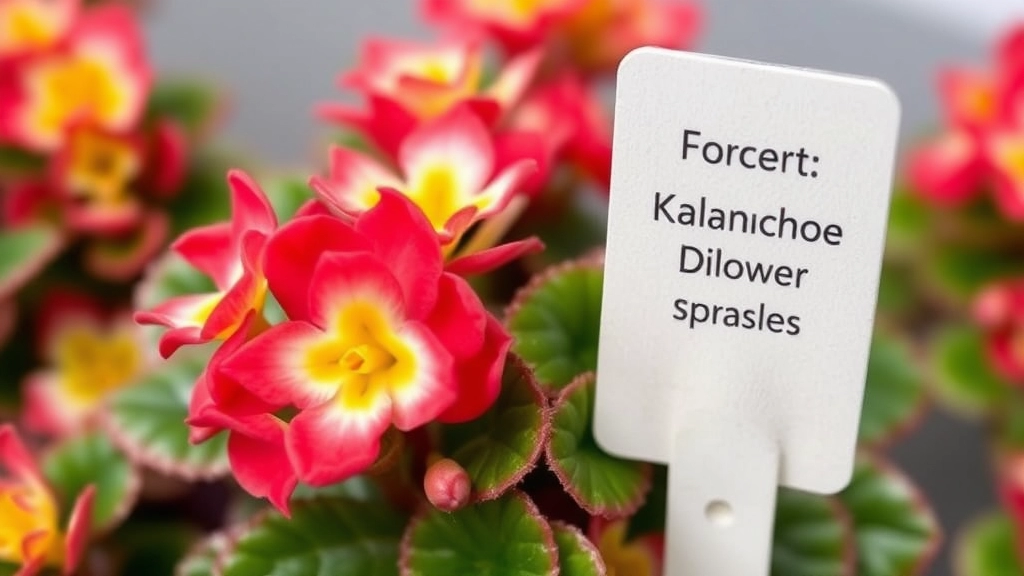
So, you’ve nurtured your Kalanchoe, and those vibrant blooms have finally graced your home. But now you’re probably thinking, “How can I keep this beauty flowering for as long as possible?” You’re not alone in this quest!
- Optimal Light Exposure
Ensure your Kalanchoe gets plenty of bright, indirect sunlight.
Too little light can lead to fewer blooms, while direct sunlight can scorch those lovely petals. - Temperature Control
Keep your plant in a warm spot, ideally between 18-24°C.
Avoid cold drafts, as these can shorten the flowering period. - Water Wisely
During flowering, water your Kalanchoe when the top inch of soil feels dry.
Overwatering can lead to root rot, which can cut blooming short. - Fertilise Regularly
Use a balanced, water-soluble fertiliser every few weeks.
This gives your plant the nutrients it needs to keep those flowers coming. - Deadhead Flowers
Snip off spent blooms to encourage new ones.
This not only keeps your plant looking tidy but also redirects energy to new growth. - Adjust Day Length
Kalanchoe is a short-day plant, meaning it needs longer nights to trigger blooming.
If you can, keep it in darkness for about 14-16 hours a day during the flowering phase.
Seasonal Care Tips for Re-blooming Kalanchoe
As we look at ways to nurture our Kalanchoe for re-blooming, it’s essential to understand the seasonal changes that can impact its growth. Many plant enthusiasts often wonder how to coax their Kalanchoe back to life after its initial flowering.
Understanding the Seasons
- Spring Awakening
- As days get longer, it’s crucial to increase light exposure.
- Gradually move your Kalanchoe to a brighter spot, ensuring it receives at least 6 hours of indirect sunlight daily.
- Summer Care
- Keep the plant in a well-ventilated area.
- Water more frequently, allowing the top inch of soil to dry out between waterings.
- Autumn Preparation
- Begin reducing water as the plant enters dormancy.
- Maintain a consistent temperature, ideally between 15-20°C.
- Winter Rest
- Limit watering to prevent root rot during the colder months.
- Keep the plant in a cool, dark place to encourage dormancy, which is vital for re-blooming.
Key Tips for Seasonal Care
- Light Regulation:
- In winter, limit light exposure to 10-12 hours daily to simulate natural conditions.
- Use blackout curtains or move the plant to a darker area.
- Temperature Control:
- Avoid placing Kalanchoe near heating vents or drafty windows.
- Aim for a stable environment to prevent stress.
- Watering Routine:
- Adjust your watering schedule based on the season.
- Always check soil moisture before watering.
- Fertilizing Schedule:
- Fertilize during the growing season (spring and summer) with a balanced, water-soluble fertilizer.
- Reduce feeding in autumn and winter.
Once your Kalanchoe has finished flowering, the care you provide is crucial for its health and future blooms. Here’s how to keep your plant thriving after its showy display.
1. Prune for Growth
- Remove Dead Flowers: Snip off the spent blooms to prevent the plant from wasting energy on seed production. For more detailed pruning techniques, check out our guide on [pruning Kalanchoe plants](https://planthq.org/pruning-kalanchoe-plants-best-tips-and-techniques/).
- Trim Back Leaves: If any leaves look yellow or unhealthy, it’s best to cut them back. This helps the plant focus on new growth.
2. Adjust Watering
- Reduce Watering: After flowering, your Kalanchoe needs less water. Allow the soil to dry out between waterings.
- Check for Signs: If the leaves start to wrinkle, it might be time for a little drink. For more watering tips, visit our [essential fall Kalanchoe care tips](https://planthq.org/essential-fall-kalanchoe-care-tips-for-healthy-blooms/).
FAQs on Kalanchoe Flower Buds
What are the ideal lighting conditions for Kalanchoe to flower?
Kalanchoe thrives in bright, indirect sunlight. Aim for around 12-14 hours of light per day. Rotate the plant regularly to ensure even growth and prevent it from leaning towards the light. Avoid direct sunlight as it can burn the leaves.
How often should I water my Kalanchoe during flower bud development?
Watering every 2-3 weeks is generally sufficient, but this can vary based on environmental conditions. Ensure the top inch of soil is dry before watering again. Overwatering or underwatering can significantly impact bud formation and overall plant health.
What type of fertilizer should I use for Kalanchoe?
Use a balanced fertilizer, such as a 10-10-10 NPK formula. Liquid fertilizers are easier to apply and absorb quickly, while slow-release granules provide a steady supply of nutrients over time. Always dilute the fertilizer to half strength to avoid burning the roots.
When is the best time to prune my Kalanchoe?
The best time to prune your Kalanchoe is right after it finishes flowering. This allows the plant to focus its energy on new growth. Regular pruning helps remove dead or wilted leaves, encourages bushier growth, and stimulates new flower bud formation.
How can I extend the flowering period of my Kalanchoe?
To extend the flowering period, ensure optimal light exposure, maintain a warm temperature (18-24°C), water wisely, fertilize regularly, deadhead spent blooms, and adjust the day length by keeping the plant in darkness for about 14-16 hours a day during the flowering phase.
What are the signs of overwatering and underwatering in Kalanchoe?
Signs of overwatering include yellowing leaves and a mushy stem. Signs of underwatering include droopy leaves and a shriveled appearance. Adjust your watering frequency accordingly to maintain the health of your plant.
Why is fertilizing important for Kalanchoe?
Fertilizing provides essential nutrients that boost growth and enhance blooming. A balanced diet of nutrients helps the plant flourish and encourages the formation of beautiful flower buds.
How should I apply fertilizer to my Kalanchoe?
Always dilute the fertilizer to half strength. Apply it after watering to help the nutrients soak into the soil without stressing the plant. Observe your plant for any signs of over-fertilizing, such as yellowing leaves.
What should I do if my Kalanchoe is not flowering well?
If your Kalanchoe is not flowering well, it might need more nutrients. Ensure you are fertilizing regularly during the growing season and providing adequate light. Pruning spent blooms can also encourage new flower formation.
How do I know if my Kalanchoe needs more nutrients?
Signs that your Kalanchoe needs more nutrients include stunted growth and poor flowering. If the plant isn’t growing as expected or if the buds aren’t forming, it might be time for a nutrient boost.
References
-
The Spruce: Kalanchoe Thyrsiflora (Paddle Plant)
-
Gardening Know How: Kalanchoe Plant Care
-
The Old Farmer’s Almanac: Kalanchoe
